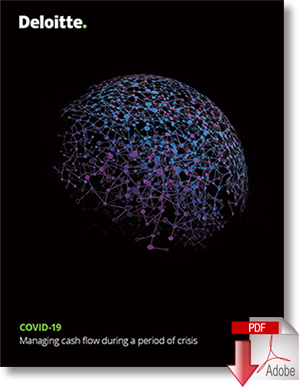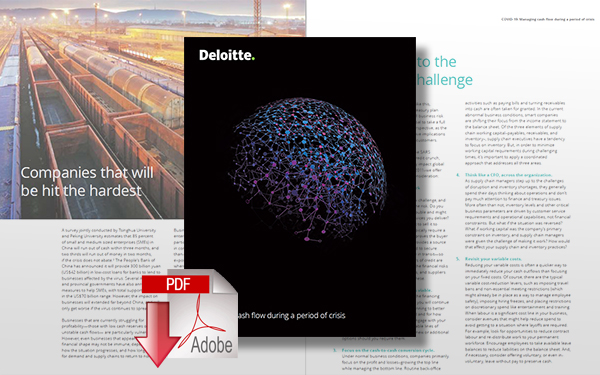Building Supply Chain Finance Goals with Real-Time Analytics

The issue with supply chain finance goals today harkens back to the inability to apply data in real-time, everyone has access to some form of data, and every process generates more of it, unfortunately, the data of the past is not always the best source for action today.
Advanced Supply Chain Technologies & Analytics
Few events carry the notoriety of black swans, and the COVID-19 pandemic is the most unprecedented and disruptive event to affect supply chains in decades.
Nothing comes close to the level of turmoil it has caused, and for supply chain leaders, the severe disruption, and changes to freight rates - not to mention limited capacity - contribute to more uncertainty.
Furthermore, the uncertainty carries over to supply chain finance goals and hopes as the world prepares for a lengthy recovery.
To stave off a complete financial meltdown, supply chain leaders need to understand how this disruption - as well as those yet to come - could be mitigated with more use of advanced supply chain technologies and analytics to build more attainable, realistic goals, collaboration among partners, and derive real value.
The Supply Chain’s Problem With Poorly Planned, Unattainable Supply Chain Finance Goals
The issue with supply chain finance goals today harkens back to the inability to apply data in real-time. Everyone has access to some form of data, and every process generates more of it.
Unfortunately, the data of the past is not always the best source for action today. It’s a simple principle that’s been around and discussed for decades.
As reported in 2011 by Supply Chain Management Review;
“The fundamental problem with current supply chain visibility and analytical models is that discovering or learning what happened in the past no longer provides a competitive advantage. History lessons may be great for business school students to ponder in case study groups. But they do not equip supply chain professionals to effectively manage the supply chain of today, and most importantly, the critical issues that will decide success and failure tomorrow.”
The only way to really know what’s right for a business is to understand its current state and demands. That is what the COVID-19 pandemic revealed - a supply chain that was so lean and fixated on a belief that nothing could bring operations to a grinding halt that it forgot the importance of resilience, agility, and flexibility.
Those three factors (resilience, agility, and flexibility) are also guardians of cost savings when problems arise, so what do supply chains really need today? To answer that question, we need to look further into the data.
Analytics Enable Data-Driven Decision Making and Real-Time Interventions in the Supply Chain
Analytics relies on a host of machine learning, artificial intelligence resources, and algorithms to review the information and generate actionable insights. It’s not enough to simply know what happened; companies need to know how to apply information. It’s that simple.
Analytics point out the opportunities that are ripe for improvement and applied across a real-time collaborative logistics platform, analytics can help companies review order-to-cash process cycles, expectations for demand, review available inventory, and better manage interactions with partners and customers. As a result, the likelihood of financial losses and out-of-stock issues decline.
Moreover, analytics-driven insights help supply chain leaders intervene when problems or changes occur, such as the need to work with a carrier offering faster delivery at a higher cost.
After all, if that faster delivery has a proven record of speed over cost, the justification for use is easier. The opposite is true as well. If a company charges less and sacrifices speed, it may be time to look for another service provider.
Analytics applications are all about how a company responds to information and avoids risk, so they are the natural choice for companies in need of a retooling of supply chain finance goals.
By that measure, analytics can create the supply chain finance goals that align with success and help companies measure their health to ensure operations align with those goals, mitigating the shock waves that derive from both black swan events and minor disruptions.
Tips for Building Better Supply Chain Finance Processes With Technology
The path to recovery from a black swan event is not so much different than the ability to mitigate losses and create attainable goals throughout routine operations.
For example, as explained by Deloitte, supply chain leaders must follow key steps to applying analytics and technology to respond to crises and maintain business continuity.
Commonalities, such as creating a robust framework, enabling transparency in payment processing, creating a fast order-to-cash conversion cycle, and managing unnecessary expenses, are expected.
However, the path to success lies in taking a holistic view of the operation and what needs to happen to achieve the desired result.
That’s the crux of supply chain analytics - providing the pathway from issue to resolution with the least costs and biggest rewards.
Of course, it always helps to have a few tips in the bag to augment your use of such technology, including:
- Connect your supply chain from suppliers through the consumer to track data.
- Use analytics to understand the full order and shipment lifecycle.
- Identify areas of weakness with data-driven decision making and automated tagging.
- Use smart search functions to isolate and address issues in real-time.
- Apply analytics-driven insights to improve the selection and use of carriers or other supply chain partners.
- Provide supply chain partners with KPIs and metrics to help them improve service levels and better meet your expectations.
- Take advantage of analytics and scenario planning to consider the countless “what if” scenarios and how your business can prepare to respond before they occur.
Practical Uses of Analytics to Improve Supply Chain Finance Outlook
For supply chain professionals to get a better sense of what types of analytics can help improve supply chain finance goals, here is a look at the following analytics dashboards built-in Turvo that allow our customers to improve their financial standing as it relates to the supply chain:
- Financial Metrics Summary: These sets of analytics measure the financial health of your business by the carrier, customer, and lanes allowing professionals to focus the business on high-margins. These metrics go a long way in the financial planning of your business, not to mention customer service levels. If we can isolate the data, we see freight under management in terms of millions of dollars, and we can drill down into specific customers, carriers, time zones, lanes, and shipment status using the filters at the top.
- Customer Quarterly Business Review (QBR) Scorecard: This set of analytics measures your performance with customers and with quick access to the data by your team as data collection is automated within the Turvo platform, this QBR analytics dashboard eliminates hours of collecting data to present your performance to customers, allowing you to retain customers and it is proven that keeping customers is critical to improving profitability.
- Carrier Scorecard: This set of analytics measures the performance of carrier partners to improve customer experience by choosing carriers with better service levels. This allows you to invoice customers faster by working with carriers that have faster upload cycles. The scorecard also helps review the number of carriers used, the shipping volume, the profit margin, the average rate per mile, the on-time pickup percentage, on-time delivery percentage, and more for a specific trade lane. This maximizes visibility and gives users the data needed to intervene and boost service levels along the way.
- Dwell & Detention Time KPIs: This set of analytics measures performance impacted by dwell time so you may improve operations by reducing calculated dwell times at high volume stops, reducing overall costs incurred from detention fees.
- Driver KPIs: This data set allows users to measure the visibility and app compliance of drivers to hold them accountable for using the driver app to track shipments so you can work with drivers that allow a greater chance to eliminate call checks, which drain on resources, to see shipment status.
- Custom Self-Serve Analytics Dashboards: In addition to these previous analytics dashboards, users can create their own reports, visualizations, and dashboards with over 200 shipments, accounts, and top-level attributes.
Leverage a Collaborative Logistics Platform That Includes Analytics to Reach Supply Chain Finance Goals
How often do you really think about collaboration in logistics and the supply chain?
It’s easy to think that everyone focuses on working together, but in the hustle and bustle, that idea gets tossed aside to the fringe. Instead of hoping to work together, supply chain leaders need to guarantee a collaborative workspace by using a platform that enables the unification of data, workflows, systems, and people.
These tenants can provide an immeasurable source of information that can help your company speed all processes from order processing through freight settlement. Find out more about how your organization can reap the benefits of better supply chain finance management through a single pane of glass platform by visiting Turvo today.
About the Author
Adam Robinson is Director of Product Marketing at Turvo Inc. He is a data-driven storytelling marketer with the quest to make supply chains as high functioning, collaborative, waste-free, and productive as possible in an altruistic endeavor to maximize human capital. Turvo provides a supply chain collaboration network that empowers the supply chain to get more out of less with a groundbreaking approach to the way professionals work.
Related: AGCO’s Supply Chain Risk Management & Strategic Sourcing Strategies - Pandemic Lessons for Everyone
Related White Papers
COVID-19: Managing Cash Flow during a Period of Crisis
As a typical “black swan” event, COVID-19 took the world by complete surprise, this paper suggests ways organizations can mitigate damages to their business during this volatile event. Download Now!
The Impact of Coronavirus on Global Supply Chains and Actions to Take
In this paper, we discuss the ins and outs of the coronavirus, with a focus on the effects the disease can - and is - having on global supply chains, and what actions you can take. Download Now!
Supply Chain Lessons Learned from The Coronavirus and SARS Outbreaks
This white paper contains insights from recent interviews with leading organizations on how they are responding to the new coronavirus crisis. Download Now!
More Resources on Supply Chain Risk Management
Article Topics
Turvo News & Resources
Lineage Logistics announces acquisition of Turvo Creating a Digital Supply Chain Platform for Real-Time Visibility and Collaboration Consumer Trust in Social Responsibility Communications: The Role of Supply Chain Visibility Building Supply Chain Finance Goals with Real-Time Analytics COVID-19: Managing Cash Flow during a Period of Crisis Disrupting the $8 Trillion Logistics Industry Shifting Patterns - The Future of the Logistics Industry More TurvoLatest in Supply Chain
Microsoft Unveils New AI Innovations For Warehouses Let’s Spend Five Minutes Talking About ... Malaysia Baltimore Bridge Collapse: Impact on Freight Navigating TIm Cook Says Apple Plans to Increase Investments in Vietnam Amazon Logistics’ Growth Shakes Up Shipping Industry in 2023 Spotlight Startup: Cart.com is Reimagining Logistics Walmart and Swisslog Expand Partnership with New Texas Facility More Supply Chain


















